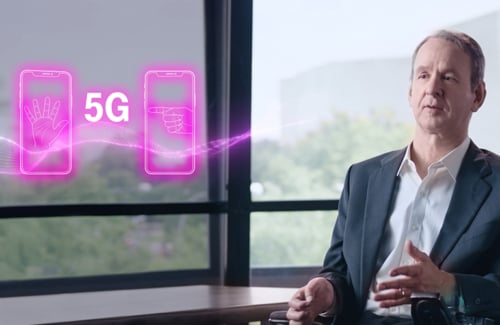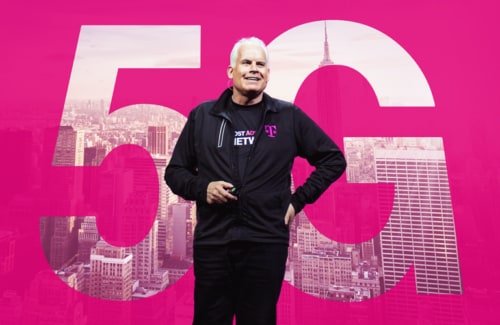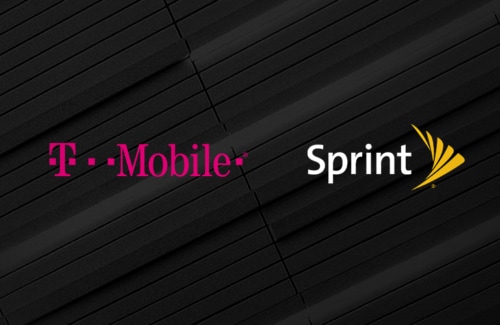Plain and simple, the planned merger between T-Mobile and Sprint will result in a truly transformative, nationwide 5G network. With the combined assets of the two companies and a significant investment in building out a new supercharged 5G network, the New T-Mobile will be able to quickly develop and deploy 5G for all. This will usher in an age of great change and massive innovation throughout the U.S., bolstering the economy – and covering 293 million Americans with 5G by 2024. Helping to finally close the digital divide gap between urban and rural areas. The impact will be lifechanging for all Americans.
To get a better sense of the reality of that impact, we’ve sought out experts in their respective fields to share their own vision of how the New T-Mobile’s nationwide 5G network will empower people across this diverse country.
Here, we talk with Henry Claypool, Technology Policy Consultant for the American Association of People with Disabilities (AAPD) – a national, cross-disability non-profit organization that serves as a convener, connector and catalyst for change, increasing the political and economic power of people with disabilities. He is the former director of the U.S. Department of Health and Human Services on Disability, an affiliated faculty member at the University of California San Francisco, and runs his own consulting firm, Claypool Consulting.
He’s also a disabled American.
“I’ve looked into some of the really persistent challenges that we’re confronting in supporting people with disabilities and noticed how technology consistently is used to leapfrog some of the barriers that they experience in everyday life,” he says. “That put me on a path to a deeper appreciation of technological innovation.”
Claypool shares his thoughts on how 5G can create a better future where people with disabilities lead more independent lives as valued members of their community.
How important is having ubiquitous 5G coverage for disabled individuals?
I think it’s crucial. We’re living in an era where connected devices are really starting to grow. So having a wireless system that can facilitate data-sharing across these different platforms is essential to their operation. With 5G, it’s a blank slate in many ways. We’re going to see new use cases emerge because innovators are going to come along and say, “Guess what I can do now with this new technology?” For example, they’ll build out systems that will help people navigate space more easily, and more naturally.
What excites you most about 5G and the innovations that it can and will bring for people with disabilities?
For people with disabilities, what I often think of is this concept of “wayfinding.” Where are you in relationship to where you’re going? Helping people move about and navigate more independently is really an area where 5G is obviously going to benefit people. So, for example, blind people right now are constrained by using physical devices like a cane or a service animal to get around. Technology, I think, can do a better job.
Imagine 5G-connected smart glasses that harness the power of artificial intelligence and give the person real-time audio feedback to help navigate a supermarket, eliminating the need to ask for assistance from someone at the store. With greater network speeds and capacity because of 5G, these data-driven solutions will only lead to greater independence and efficiency for disabled people. New advances like facial recognition will tell them who is approaching, bus and train routes will be easily accessed, food on shelves in that supermarket identified. The world really opens up.
Is latency a problem for disabled individuals, and does 5G offer a solution?
Yeah, certainly. For instance, right now people that are deaf in large part use a visual language, American Sign Language (ASL) in the U.S. They gesture to one another and use facial expressions and body gestures to communicate an awful lot of meaning. It can be very subtle and nuanced. And when you’re doing that remotely it can be a challenge, because of some of the limits now that we have on the ability of our technology or infrastructure to transmit data. Latency is the killer of this. Any lag in the signal will result in a jumpy expression and really ruin the authenticity of the communication. With 5G, that latency issue virtually goes away.
It’s not just deaf people. Hearing people actually rely on the interpreter as much as the deaf person does. So 5G could really facilitate the broader inclusion of people that rely on or that use ASL as their primary language, and allow them to participate more seamlessly in our society.
Is there an aspect of 5G technology that you are personally invested in, something that might impact you directly that you’re looking forward to?
As somebody living with a disability myself, I’m excited to see what it can do – from opening up new job possibilities to tackling mundane day-to-day tasks. For people who want to live independently in their homes, beyond just controlling the thermostat and the lights. We need to do a better job of figuring out how technology and automation can play a role in providing supports or assistance with everyday needs – like helping people with dressing, bathing, food prep, doing laundry. Which is almost exclusively the domain of human assistance right now.
Don’t get me wrong, I don’t think we should cut out human interaction. I think it’s important for us to think about how technology can lift up human interactions, and support them to engage in higher-order tasks – getting out into the community, going to a movie, activities that enhance quality of life. Instead of just saying, “I’m here for two hours to help you around the house. But after that, I’m on my way.”
If we can find a way with the help of 5G to give those two hours over to deeper, richer human interactions and connection, we’ll add quality to the life of these individuals, allowing them to be more engaged – and enjoy themselves. And isn’t that what life is really all about?
Important Additional Information
U.S. Securities and Exchange Commission (the “SEC”) on October 29, 2018, and which contains a joint consent solicitation statement of T-Mobile and Sprint Corporation (“Sprint”), that also constitutes a prospectus of T-Mobile (the “joint consent solicitation statement/prospectus”), and each party will file other documents regarding the proposed transaction with the SEC. INVESTORS AND SECURITY HOLDERS ARE URGED TO READ THE JOINT CONSENT SOLICITATION STATEMENT/PROSPECTUS AND OTHER RELEVANT DOCUMENTS FILED WITH THE SEC WHEN THEY BECOME AVAILABLE BECAUSE THEY WILL CONTAIN IMPORTANT INFORMATION. The documents filed by T-Mobile may be obtained free of charge at T-Mobile’s website, at www.t-mobile.com, or at the SEC’s website, at www.sec.gov, or from T-Mobile by requesting them by mail at T-Mobile US, Inc., Investor Relations, 1 Park Avenue, 14th Floor, New York, NY 10016, or by telephone at 212-358-3210. The documents filed by Sprint may be obtained free of charge at Sprint’s website, at www.sprint.com, or at the SEC’s website, at www.sec.gov, or from Sprint by requesting them by mail at Sprint Corporation, Shareholder Relations, 6200 Sprint Parkway, Mailstop KSOPHF0302-3B679, Overland Park, Kansas 66251, or by telephone at 913-794-1091.
No Offer or Solicitation
This communication shall not constitute an offer to sell or the solicitation of an offer to buy any securities, nor shall there be any sale of securities in any jurisdiction in which such offer, solicitation or sale would be unlawful prior to registration or qualification under the securities laws of any such jurisdiction. No offering of securities shall be made except by means of a prospectus meeting the requirements of Section 10 of the U.S. Securities Act of 1933, as amended.
Cautionary Statement Regarding Forward-Looking Statements
This communication contains certain forward-looking statements concerning T-Mobile, Sprint and the proposed transaction between T-Mobile and Sprint. All statements other than statements of fact, including information concerning future results, are forward-looking statements. These forward-looking statements are generally identified by the words “anticipate,” “believe,” “estimate,” “expect,” “intend,” “may,” “could” or similar expressions. Such forward-looking statements include, but are not limited to, statements about the benefits of the proposed transaction, including anticipated future financial and operating results, synergies, accretion and growth rates, T-Mobile’s, Sprint’s and the combined company’s plans, objectives, expectations and intentions, and the expected timing of completion of the proposed transaction. There are several factors which could cause actual plans and results to differ materially from those expressed or implied in forward-looking statements. Such factors include, but are not limited to, the failure to obtain, or delays in obtaining, required regulatory approvals, and the risk that such approvals may result in the imposition of conditions that could adversely affect the combined company or the expected benefits of the proposed transaction, or the failure to satisfy any of the other conditions to the proposed transaction on a timely basis or at all; the occurrence of events that may give rise to a right of one or both of the parties to terminate the business combination agreement; adverse effects on the market price of T-Mobile’s or Sprint’s common stock and on T-Mobile’s or Sprint’s operating results because of a failure to complete the proposed transaction in the anticipated timeframe or at all; inability to obtain the financing contemplated to be obtained in connection with the proposed transaction on the expected terms or timing or at all; the ability of T-Mobile, Sprint and the combined company to make payments on debt or to repay existing or future indebtedness when due or to comply with the covenants contained therein; adverse changes in the ratings of T-Mobile’s or Sprint’s debt securities or adverse conditions in the credit markets; negative effects of the announcement, pendency or consummation of the transaction on the market price of T-Mobile’s or Sprint’s common stock and on T-Mobile’s or Sprint’s operating results, including as a result of changes in key customer, supplier, employee or other business relationships; significant transaction costs, including financing costs, and unknown liabilities; failure to realize the expected benefits and synergies of the proposed transaction in the expected timeframes or at all; costs or difficulties related to the integration of Sprint’s network and operations into T-Mobile; the risk of litigation or regulatory actions; the inability of T-Mobile, Sprint or the combined company to retain and hire key personnel; the risk that certain contractual restrictions contained in the business combination agreement during the pendency of the proposed transaction could adversely affect T-Mobile’s or Sprint’s ability to pursue business opportunities or strategic transactions; effects of changes in the regulatory environment in which T-Mobile and Sprint operate; changes in global, political, economic, business, competitive and market conditions; changes in tax and other laws and regulations; and other risks and uncertainties detailed in the Form S-4, as well as in T-Mobile’s Annual Report on Form 10-K for the fiscal year ended December 31, 2018 and in its subsequent reports on Form 10-Q, including in the sections thereof captioned “Risk Factors” and “Cautionary Statement Regarding Forward-Looking Statements,” as well as in its subsequent reports on Form 8-K, all of which are filed with the SEC and available at www.sec.gov and www.t-mobile.com. Forward-looking statements are based on current expectations and assumptions, which are subject to risks and uncertainties that may cause actual results to differ materially from those expressed in or implied by such forward-looking statements. Given these risks and uncertainties, persons reading this communication are cautioned not to place undue reliance on such forward-looking statements. T-Mobile assumes no obligation to update or revise the information contained in this communication (whether as a result of new information, future events or otherwise), except as required by applicable law.





